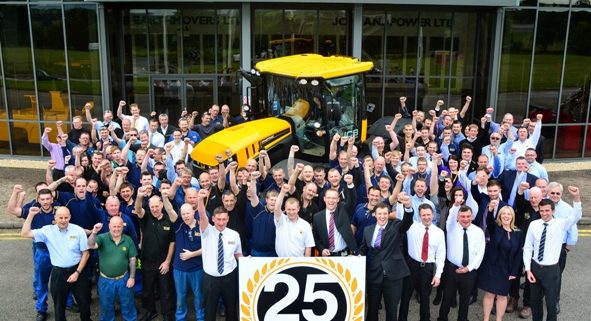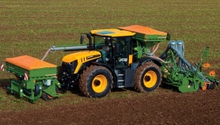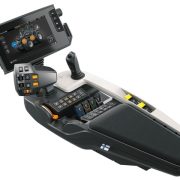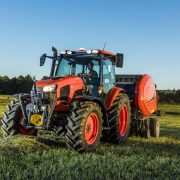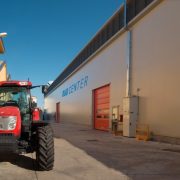The emblematic tractor of JCB celebrates 25 years serving Agriculture
Fastrac, emblematic tractor of firm JCB celebrates its 25th anniversary in the service of Agriculture. In the words of his company “this range of agricultural tractors retains its unique character today and offering its customers an unmatched combination of features and performance benefits that achieve high levels of productivity and use.” It is therefore one of its most distinctive, productive and sophisticated models.
The president of JCB, Lord Anthony Bamford, was who had the idea of making a non-conventional tractor while on holiday abroad in 1984. He saw a great opportunity to develop a tractor that had high road speed and also be able to perform field work, including heavy applications. His inspiring idea would become reality a few years later, when it was introduced worldwide the first tractor with full suspension.
Fastrac design has evolved considerably since the first prototype created in 1987 behind the current premises of JCB Transmissions in Wrexham, North Wales. The tractor met technologies and components organized in a new way, not only offered an exceptional driving comfort for an agricultural tractor thanks to built in both ejes- suspension, but also, as would prove the first tests, ending the myth that the suspension and the plow is an impossible combination.
In the previous development of its design, the prototypes selected to rate their performance and make appropriate adjustments before presenting the result of the P120 project, with a budget of 12 million pounds, to the media farmers trusted and the public at the Royal Smithfield Show 1990. The production of this new tractor line would begin in the spring of the following year.
Characteristics
Aside from being the first agricultural tractor high-capacity drive with complete and capable of reaching maximum speeds of 75 km / h (47 mph) over the past 25 years, Fastrac suspension has been the first to feature disc brakes, as trucks, toward the four Multimode wheels, antilock brakes (ABS) and self-leveling suspension. It was also the first, and remains the only tractor, which combined these features with an advanced variable transmission, electronically managed continuously.
Its speed in the field and comfort are two of the attributes that most praised the first users of Fastrac and what influenced the development of its design, to continuously improve their ability to field work while their unmatched performance as transport vehicle. The Selectronic Powershift transmission with two speed was one of the first improvements to the Fastrac that were introduced two years after the presentation of 125 (120 hp) and the 145 Turbo (140 hp) in 1991. The number of working speeds Doubled and preselection system was incorporated to facilitate changes in scope and meaning.
And of course, the new Fastrac acquired more power, a topic that is regularly repeated in the following years, with the addition of 150 hp Fastrac 170 in 1993 and 185 Fastrac 170 hp.
In 1995, JCB is pulled off another surprise with the Fastrac 1115, a smaller agile tractor, light and with a top speed limited to 50 km / h (31 mph) so that it could carry standard tires instead of high speed. That same year was joined by a turbocharged version with 135 hp.
Versatile direction
Then JCB engineers applied their experience in the design of steering systems to all four wheels for multimode Loadall telescopic handlers, in the manufacture of Quadtronic system for Fastrac 1115 and 1135. This sophisticated configuration reduced turning radius by 25% and was so successful that it remains a standard feature on the Fastrac tractors of the current 4000 series. Operators can select the direction of two wheels for the road towards the rear axle delay when turning lanes to exit or row crops or using True Tracking to the rear wheels follow exactly to the front.
The circular direction allows turns with smaller radius and tractors can even use the address crab to overcome slopes or distribute its weight among the four wheels.
A model with a longer wheelbase, the 148 hp 2150, joined the range of “small Fastrac” when in 1998 the line received a significant upgrade with new engines and 54×18 Autoshift transmission. Introduced in the two new models of “big Fastrac” 3000 series at the same time, automatic Powershift three-speed transmission reduced the workload of the operator and incorporated modes field and road to make the appropriate changes in different circumstances.
The wet clutch transmission Smoothshift assumed durability and operational improvement for all Fastrac tractors in 2000, and the following year, the exclusive DLD (ABS) JCB brought new levels of security and protection. Although the ABS is widely used in road vehicles, engineers JCB created a system that not only resisted the heavy mass of all the wheels of a tractor on asphalt with good grip, but also on slippery grass and loose surface rural roads.
JCB entered into new sectors 8250 Fastrac tractors with 250 hp in 2005, the year of the 60th anniversary of the company, and 7000 series Fastrac 178 hp to 270 hp in 2008. The first introduced the CVT transmission in the range Fastrac while the latter presented the semi-powershift transmission P-Tronic 24×9 speeds JCB, which was mounted with great success in Fastrac 3000 Xtra models from 2011.
Were stablished two new models of the 8000 series and new levels of performance the same year, with the introduction of Fastrac 3210. This newcomer took the Fastrac range beyond 300 hp for the first time and introduced a new engine, electronic traction with established power modulation control and new features for progressive V-Tronic transmission.
Fastrac 4000 series, the most advanced
Agritechnica 2013, meanwhile, marked one of the most significant steps in the most recent history of the development of Fastrac, when the preview of the current 4000 Series tractor was performed. With three power outputs from 175 hp to 235 hp, a CVT transmission, suspension with front and rear self-leveling, address to all four wheels multimode, sophisticated hydraulics and cab mounted on the central part that offers more space than ever and visibility Altogether, this newcomer is the most advanced in history Fastrac.
Tim Burnhope, responsible for engineering and innovation JCB, said: “The Fastrac 4000 series is such a complete tractor in all aspects attracting both users who had never used a Fastrac as enthusiastic lifelong Offering specifications. the design of the cab, engine performance and control and flexibility of transmission that are at least as good as those of other tractor of comparable power, the advantages of the total suspension, steering to the four wheels and disc brakes, who first used the tractor recognize that now convince them of the advantages provided Fastrac without any problem. ”
Despite how good is the standard Fastrac, has also recognized its potential for modification to suit specialized applications, and Fastracs are built with extended chassis for spraying and spreading lime/fertilizer, including versions of six wheels and vehicles spread in Australia
Conversions road/rail allow vegetation removal work along the tracks and other maintenance and Fastrac can be seen in airports to remove snow and ice from the tracks. But the most modified Fastrac is used by the US military: incorporates a hydraulic backhoe loader and is capable of traveling at high speed in convoys and fits into the loading platform of a transport plane C-130 Hercules.
The Fastrac has also enjoyed moments of fame; It is the only tractor that has appeared twice in the BBC program Top Gear, in the original release and when The Stig set a time of 2 minutes and 57 seconds on the test track aerodrome.
And it is the only tractor that tried to break a world record. In 2006, a Fastrac 8250 capable of reaching 105 km / h (65 mph) used the JCB Dieselmax modified during the starting procedure for your successful attempt to beat the speed record for diesel on the ground.
Currently, the Fastrac in all its forms remains unique and offers a combination of design and technical features allow a high level of use thanks to its versatility, high productivity gained from its performance and comfort unmatched driving in the field and road.
Source: JCB




